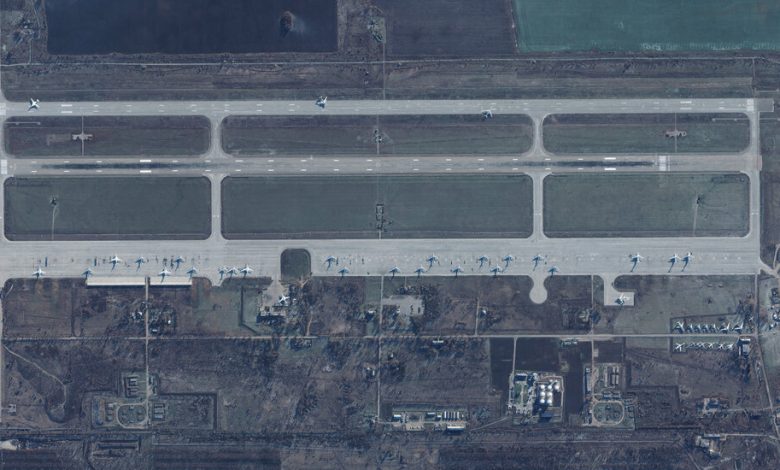Your Tuesday Briefing


Engels air base, about 300 miles from the Ukrainian border.Credit…Maxar Technologies, via Reuters
Ukraine attacks Russian air base
Ukraine launched a drone attack on the Engels air base deep within Russian territory, killing three troops, the Kremlin said yesterday, as Kyiv’s forces demonstrated that they were increasingly prepared to take the fight to Russia. Engels, home to some of Russia’s nuclear-capable strategic bombers, was one of two air bases targeted by Ukrainian drones on Dec. 5.
It was the third such strike this month, reflecting an assessment by Ukraine’s political and military leaders that there was little risk of Moscow’s escalating its war in retaliation. The Russian military is already fighting at the limits of its conventional capabilities, Ukrainians say, and the Kremlin’s hints of using nuclear weapons ring hollow.
In the months after Russia invaded, Ukraine’s allies voiced concern about attacks on Russian soil and the risk of retaliatory escalation, as the Kremlin has threatened repeatedly. The U.S. and others still refuse to supply Ukraine with long-range weapons and insist that the weapons they do provide not be used to fire into Russia, but the fear of escalation has abated.
Context: Ukraine has struck repeatedly at military targets in Crimea and other Russian-occupied territory that Moscow now claims as its own, as well as at infrastructure like the Kerch Strait Bridge linking Crimea to Russia. Now Ukraine is stepping up attacks into Russia itself.
In other news from the war:
-
Russian mercenaries with the same shadowy Wagner Group now fighting in Ukraine have already established control in the Central African Republic, where Moscow has gold and diamond mining interests.
-
Ukraine’s foreign minister said that his government hopes to have a peace summit by the end of February, about one year after Russia invaded Ukraine.
Dozens killed in winter storm
As a fierce storm brought bitter cold to much of the U.S., western New York was hit particularly hard, with at least 28 people killed over four days of the blizzard. At one point on Friday, roughly two-thirds of the U.S. population was under winter warnings or advisories.
Officials in Buffalo, where there is as much as 49 inches (125 centimeters) of snow on the ground, said it was the worst winter storm in more than 50 years. Many roads were left impassable, thousand of people are still without power and the death toll is expected to rise. Scores of vehicles were abandoned during the storm and had yet to be removed, an official said.
The bad weather left thousands of travelers stranded at airports across the country, as a wave of canceled flights spoiled holiday plans and kept families from returning home during one of the busiest travel stretches of the year. People were forced to sleep on airport floors and wait for hours on end on tarmacs or in customer service lines.
Elsewhere: Strong winds took down power lines throughout the country. In Maine, one of the states hit hardest by power outages, more than 17,000 homes and businesses remained without power on Monday afternoon, according to state utility companies’ maps.
A Nord Stream mystery
Three months after a blast ripped through the Nord Stream gas pipeline, neither a culprit nor a motive have been identified. Many European governments and experts see Russia as the most likely saboteur. But the theory that Russia carried out the blasts has only become more complicated.
Russia has quietly taken steps to begin expensive repairs on the giant gas pipeline. Consultants for Russia are also studying how long the damaged pipes can withstand saltwater exposure. The inquiries raise the question of why, if Moscow bombed its own pipelines, it would begin the expensive work of repairing them.
The pipeline, which runs along the Baltic Sea floor between Russia and Germany, is a challenging crime scene to investigate. The cables are not closely monitored, and vessels passing by can easily hide by turning off their tracking transponders.
Background: Before Nord Stream came online, many feared that it would make Europe too reliant on Russian gas, giving Moscow a lever over the E.U. with its ability to turn off supplies.
THE LATEST NEWS
Around the World
-
A man was indicted on charges of murder and attempted murder with a racist motive yesterday, after a shooting left three people dead in central Paris last week.
-
China sent a record number of military aircraft to menace Taiwan, in a large show of force to the Biden administration.
-
Even as official figures on Covid infections from China’s central government remained low, regional numbers indicated an explosive outbreak of the virus.
-
Nepal’s Parliament elected a new prime minister: Pushpa Kamal Dahal. The former rebel leader has led Nepal twice before and will likely keep the old guard in power, despite calls for change.
Other Big Stories
-
Several international aid organizations temporarily suspended operations in Afghanistan after the Taliban barred women from working at nongovernmental organizations.
-
After snow stranded its van in front of a house in New York, a South Korean tour group spent the weekend with local residents.
-
After their success in the midterms, Democrats are fighting to expand voting access.
A Morning Read
“First I eat my sandwich then I open my drink, then eat my fruit and last but not least my treat. After that I sit quietly until I am dismissed. When I am I go into to the bathroom and clean my teeth because I have braces.”
Who wrote this — a 10-year-old child or a bot? To better understand the potential of ChatGPT, an A.I. chatbot released last month, The Times asked experts to identify which essays were written by bots and which by children. Can you tell the difference?
SPORTS NEWS FROM THE ATHLETIC
Each Premier League club’s plans for the January transfer window: Who could be signing, who might be off and who calls the shots? Our club writers cast their eyes over the top flight’s transfer prospects.
The Athletic’s 2022 soccer quiz: Test your knowledge with a review of the year, including questions on 30 years of the Premier League, the World Cup and more.
The soccer clubs that came back to life: Soccer clubs mean everything to their communities. When some have gone to the wall, fans have stepped in to rebuild.
ARTS AND IDEAS
Times past
Jennifer Parrucci is a senior taxonomist at The Times who spends her time digging through the paper’s 171-year archives. She spoke to The Morning, our sister newsletter, about her work. This is a lightly edited extract.
What exactly is a taxonomist?
I make sure our current articles can be easily searched and categorized. That work grew out of The New York Times Index, which is a reference book of every person, organization, location and event the paper has written about. It started being published regularly in 1913.
I’ve also created a massive spreadsheet of fun gems I’ve found combing through the archives, mostly as a passion project. You go in and sometimes find things serendipitously, from the serious to the ridiculous, like an attempted robber who got caught because he stopped for lemonade or a man who only ate pickles and crackers and ended up in the hospital.
Searching must get complicated as events — and the paper’s coverage — evolve.
It does. World War I wasn’t indexed as World War I, because the archivists back then didn’t know there would be another. So you have to think, OK, what would it have been called?That’s one thing about the archives: Things change. Language changes. We used words we don’t use today. We framed things in ways we don’t now.
You can also see how our journalistic standards have changed. My favorite archival project I’ve done was to collaborate on two books: “Cats of The Times” and “Dogs of The Times.” I got to go find every dog and cat story in the archives. I don’t know that a story about a cat running through a church would make Page 2 of the paper today, but it did in 1897.
TimesMachine is an online archive of issues going back to 1851 that can be accessed by all. What is the value of making the archives publicly available?
Context. The day men first landed on the moon in 1969, for example, a story about the Chappaquiddick car accident involving Senator Ted Kennedy was also on the front page. So was a story about the first man to row solo across the Atlantic. If you couldn’t flip through digital pages, you wouldn’t know those stories appeared next to each other.
PLAY, WATCH, EAT
What to Cook
This vegetarian borscht comes together in less than an hour.
What to Read
Times readers recommend some of the best books they read in 2022.
What to Watch
“Corsage” is a visually striking and ingeniously anachronistic portrait of Elisabeth Amalie Eugenie, the empress of Austria.
Now Time to Play
Here’s today’s Mini Crossword, and a clue: Macaroni shape (five letters). For more, read how the Japanese attack on Pearl Harbor ushered the Times Crossword into print.
And here are today’s Wordle and the Spelling Bee.
You can find all our puzzles here.
That’s it for today’s briefing. Thanks for joining me. — Natasha
P.S. “Happiness Is £4 Million,” a video from our Opinion desk, is on the shortlist for the Academy Awards in the documentary short film category.
The latest episode of “The Daily” is on Ukrainians making their escape from Russia.
You can reach Natasha and the team at [email protected].



